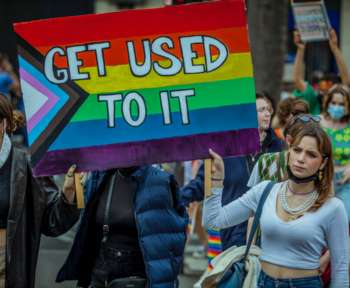Existing as a girl under the patriarchy isn’t easy.
An article by Maxine Katz and Ronja Zemmrich
As young women growing up under the patriarchy, we realize that the constraints and pressures we suffer under seem to be infinite. Our oppression is not only manifested in ageism, but also in many other factors, considering the fact that we are girls living in a man-dominated world.
It is all around us
The unique intersection of age and gender make girls coming of age particularly vulnerable to physical, emotional, sexual, and mental health issues. The marxist-existentialist Simone de Beauvoir once wrote: „One is not born, but rather becomes a woman.”
Learn to be a women
The time of girlhood acts as a preparation. It is a transition between being a child and being socialised as a woman. One could claim that to be female is created by society. The “proper” way to dress, speak, behave and think is taught. Therefore our society’s view of femininity is demonstrated through an alteration of self.
The role teenage girls take on in our society can be described as a double-edged sword. Due to the fetishisation of youth, teenage girls are regarded as the beauty standard. Most beauty standards, such as smooth skin and hairless bodies, are rooted in pedophilia and lead to young girls being regarded as the embodiment of these ideals. Girlhood is most often represented as a glamorous and golden time for women. During this period women are seen as being at the peak of their existence. It also seems as if girls have true power at this time. This power manifests itself in the ability of getting into clubs, receiving attention and free drinks.
What girlhood truly means
But this “power” is not given, it is lent. It does not exist unconditionally, but at the expense of teenage girls’ humanity. Teenage girls’ bodies are objectified and ultimately only seen as a commodity. The privileges are only given in return for the possibility of sex. Ultimately, this position is also fleeting and precarious, as women over the age of thirty are not truly valued by society in the way teen girls are.
The sexualisation young women experience is even more prevalent for teenage girls of color, as they are deemed as more mature. As Mikki Kendall suggests in her book “Hood Feminism”, this “adultification removes the possibility of innocence from young girls, especially Black girls.”
The downside is often accepted
This intrinsic relationship between girls, their appearance and society lead to an internal conflict. Many girls seek this power that they are offered, all though they are aware that it is disempowering and damaging. It is damaging in the sense that it furthermore supports this relationship, as well as leading to self-objectification.
A paradoxical circumstance arises: In order for girls to gain power, they have to give up their already existing power in order to appeal to men. The only impression girls have of femininity is aimed for male consumption. And while girls are aware of their precarious position, they realise that this situation only occurs because their worth is not dependent on their own humanity, but only because of their relation to men.
What if I just refuse
One can observe that the benefits of girlhood are conditional to the fulfilment of certain standards. But what if these impossible standards are not met? By not achieving these ideals, it leads to a disconnect from girlhood, as it is portrayed. Because the “perfect girl” is an ideal formed to maximize consumption and furthermore fuel capitalism, the standard is purposefully unattainable. The mold of womanhood is designed to enforce the notion that it is only attainable through consumption, which it at last will never be. This disconnect often leads to the attempt of trying to separate oneself from other girls, as well as the internalising of misogyny.
Now, how are girls coming of age perpetuating and reproducing patriarchal regimes? The answer lies in structured misogyny (internalized by women to an extent as by men, revealing itself in “Girl-Hate”) and the power it has on young female bodies. Internalised misogyny starts in kindergarten and primary school, therefore becomes a constant companion of one’s girlhood.
Competition above cooperation
Having a restricted view of femininity and womanhood where a girl/woman must subvert all traditional notions of womanhood and challenge the existence of others, deems feminine relationships as a competition rather than collaboration. Yes, internalised misogyny can be perceived as the antithesis of feminism, however it is unfortunately an obstacle that most feminists have to engage with, due to the inherent patriarchal structure of our world.
The appeal at this point must be: Only profound cooperation between girls from young on (especially in a transitioning period such as girlhood) helps to stop the perpetuation of the discriminatory structures of patriarchy. The key word here may be solidarity. In this situation we cannot rely on the allyship of men, as we cannot count on them to liberate us from the system they benefit from. The different manifestations of patriarchal constraints around the world affect women to very different degrees. Cooperation without solidarity can therefore not exist.
Polen legt den Rückwärtsgang ein: Wie unser Nachbarland LGBTQIA*-Rechte mit Füßen tritt.










